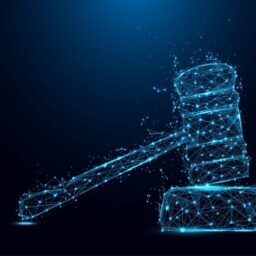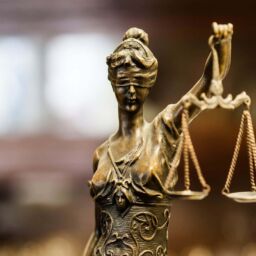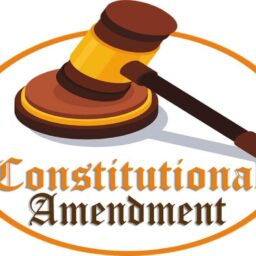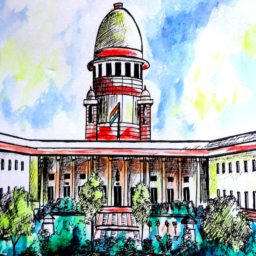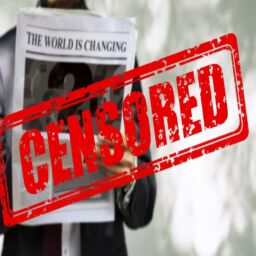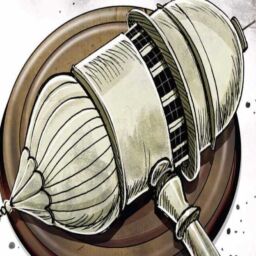Background of Emergency
On June 12, 1971, Justice Jagmohan Lal Sinha of the Allahabad High Court declared Indira Gandhi’s election to the Lok Sabha invalid. This decision was made in response to an election petition submitted by Raj Narain, a socialist politician who ran against her in 1971. The petition challenged Indira Gandhi’s election on the grounds that she had recruited government employees in her election campaign. As a result of the High Court’s decision, she was no longer a Member of Parliament and could not continue to serve as Prime Minister unless she was re-elected as an MP within six months. The Supreme Court gave her a temporary stay on the High Court judgement until her appeal was heard on June 24, allowing her to remain an MP but preventing her from participating in Lok Sabha proceedings.[1]. Indira Gandhi’s resignation was demanded by opposition political groups led by Jayaprakash Narayan, who planned a major demonstration in Delhi. Jayaprakash called a nationwide Satyagraha demanding her resignation on June 25, 1975 and asked the army not to obey her illegal and immoral commands. The proclamation for Emergency was therefore declared on 25 June 1975 under Article 352 (1) of the Indian Constitution. The Indira Gandhi led Government claimed that there was a threat of internal disturbances and therefore it invoked Article 352[2]. On the night of June 25, 1975, the prime minister suggested that President Fakhruddin Ali Ahmed declare a state of emergency. A large number of opposition leaders and workers were arrested in the early hours of the morning after the electricity to all major newspaper offices was shut off around midnight. After all of this, the cabinet was notified about it at a special meeting held at 6 a.m. on June 26.
Some of the Judgements given by the Supreme Court and various High Courts for the Writ Petitions that were filed during the Emergency Period
Today, the Supreme Court stands as the apex court for serving justice to the Indian citizens but during the emergency period, even the Supreme Court was shadowed by the evil diktats of the government. A large number of writ petitions under Habeas Corpus were filed on behalf of the leaders and workers of the opposition who got arrested due to preventive detention. The arrests done under preventive detention were taken to be immune from judicial scrutiny. The High Courts, on the other hand, disagreed, ruling that the petitions were maintainable and may be pursued despite the Presidential Order. The judgements of Delhi High Court, Gujrat High Court, Bombay High Court etc. Portrayed a strong denial of the government’s stand and they gave their rulings in favour of the detainees[3]. Mr Kuldip Nayar of “The Indian Express” was arrested and jailed under MISA on July 24, 1975. Mrs Bharati Nayyar, his wife, petitioned the Delhi High Court for a writ of habeas corpus. Mr V. M. Tarkunde successfully argued the petition on his behalf. On September 15, 1975, the Delhi High Court approved Mrs Nayyar’s plea and dismissed her husband’s detention order.[4] In agreement with his colleague, Mr Justice R.N. Agarwal, Mr Justice S. Rangarajan stated that the writ of Habeas Corpus has not been suspended in India and that citizens’ personal liberty must be regulated by legislation. One important challenge to the emergency was given in the Nathwani Case. It challenged the ban on meetings in Bombay. The All-India Civil Liberties Conference was held in Ahmedabad on 12 October 1975. The Conference voted resolutions criticising the arbitrary arrests and censorship order and calling for the Emergency Proclamation to be revoked, the detainees to be released, civil freedoms to be restored, and a general election for the Lok Sabha to be held before the first week of March 1976. On October 18, 1975, another meeting was to be held to discuss “Civil Liberties and the Rule of Law under the Constitution.” Mr J. C. Shah, Mr M. C. Chagla and Mr Nathwani were to be the principal speakers. Not only did the Commissioner of Police refuse permission for a meeting of lawyers confined to the invitees, but the State Government passed a special Order banning the holding of any public meeting where the Emergency was to be discussed or even referred to except after the prior permission of the authorities. Mr. Nathwani and the office bearers of the Committee formally sought permission. They filed a writ petition in the Bombay High Court under Article 226 of the Constitution in response to the refusal. 157 lawyers led by Mr. N. A. Palkhivala appeared for the petitioners. The Court granted the petition, ruling that the petitioners have the right to conduct an invitation-only gathering of lawyers to discuss civil rights issues. The meeting can be held on the decided date due to the pendency of the petition. The orders refusing permission were also quashed. The case was addressed by Chief Justice R. M. Kantawala and Mr. Justice V. D. Tulzapurkar[5]. However, all the activism showed by various High Courts in the upcoming cases came to a standstill after the Supreme Court overruled all the decisions of the various High Courts in the case of ADM Jabalpur v. Shiv Kant Shukla[6]. The case was addressed by the Constitution Bench of the Supreme Court consisting of Chief Justice AN Ray, HR Khanna, MH Beg, YV Chandrachud and PN Bhagavati. The majority of the judges except Justice HR Khanna held: “In view of the Presidential Order dated 27 June 1975 under clause (1) of Art.359 of our Constitution no person has locus standi to move any writ petition under Art.226 before a High Court for habeas corpus or any other writ or order or direction to enforce any right to personal liberty of a person detained under the Act on the grounds that the order of detention or the continued detention is for any reason not under or in compliance with the Act or is illegal or mala fide.”[7]. Justice H R Khanna was vocal in his dissent towards this ruling, and he paid the price when he was replaced as Chief Justice by Justice M H Beg.[8] Mr Niren De, the Attorney General, represented the government. The Attorney General argued that the detainees had no right to seek a writ of habeas corpus because all fundamental rights were suspended under the emergency, including Article 21 of the constitution. As a result, Justice Khanna enquired, “Life is also contained in Article 21. Would the government’s arguments apply to it as well?” “Even if life were to be taken illegally during the Emergency, the courts are helpless,” the Attorney General responded, and the Supreme Court ruled in favour of the government, overturning the decision of nine high courts that the legality of detaining orders passed by governments could still be challenged.[9]
Conclusion
Thus, to conclude, the High Courts had come out with flying colours during the emergency crisis. But the record of the Supreme Court was unfortunately very disappointing, mainly because the then Chief Justice Mr AN Ray owed his position to Miss Gandhi who made him the CJI after superseding the seniority of three judges. The Supreme Court’s ruling in the matter of ADM Jabalpur v. Shiv Kant Shukla is still regarded as a scar on the Indian judicial system. One group of people believes that the Emergency was declared not because of a threat of domestic unrest, but rather because Indira Gandhi’s control on power was eroding. The report of the Shah Commission and now the book The Emergency by Coomi Kapoor shows that the concrete groundwork for an internal Emergency had started much earlier and Indira Gandhi was being guided by a core group close to her, namely Siddhartha Shankar Ray (chief minister of West Bengal), D.K. Barooah (Congress president), Rajni Patel (chairman of the Bombay Pradesh Congress Committee) and Balasahab Gokhale[10]. The judgement of the Supreme Court was not only legally unsound but also harmful for the people of the country. It was a mockery of Justice. It might also be possible that the emergency proclamation would have collapsed by 1976 if the Supreme Court would have taken a firm stand at that moment itself. But all we can do now is hope that the judiciary never undergoes such a dark period again and there should not even be an iota of injustice anywhere.
As it is rightly said, “Injustice anywhere is a threat to justice everywhere.”
– Martin Luther King
Author(s) Name: Geetanjali Anand (Institute of Law, Nirma University, Ahmedabad)
References:
[1] Khilnani, S., 2021. Politics in India since Independence. 14th ed. New Delhi: Publication Division by the Secretary, National Council of Educational Research and Training, pp.108 and 109.
[2] Khilnani, S., 2021. Politics in India since Independence. 14th ed. New Delhi: Publication Division by the Secretary, National Council of Educational Research and Training, pp.108 and 109.
[3] Noorani, A., n.d. THE JUDICIARY AND THE BAR IN INDIA DURING THE EMERGENCY. [online] Jstor. Available at: <https://www.jstor.org/stable/43108733> [Accessed 22 September 2021].
[4] Noorani, A., n.d. THE JUDICIARY AND THE BAR IN INDIA DURING THE EMERGENCY. [online] Jstor. Available at: <https://www.jstor.org/stable/43108733> [Accessed 22 September 2021].
[5] N. P. Nathwani vs. The Commissioner of Police, 78 (1975) Bom LR
[6] ADM Jabalpur vs. Shivakant Shukla, (1976) 2 SCC 521
[7] (This excerpt from the judgement is taken from the article of Mr A.G Noorani) Noorani, A., n.d. THE JUDICIARY AND THE BAR IN INDIA DURING THE EMERGENCY. [online] Jstor. Available at: <https://www.jstor.org/stable/43108733> [Accessed 22 September 2021].
[8] Pandey, A., 2016. The Darkest Hour in Judicial History – When the SC Surrendered Its Autonomy During Emergency. [online] IndiaTimes. Available at: <https://www.indiatimes.com/news/india/the-darkest-hour-in-indian-judicial-history-when-the-supreme-court-surrendered-its-autonomy-during-emergency-254859.html> [Accessed 22 September 2021].
[9] Noorani, A., n.d. THE JUDICIARY AND THE BAR IN INDIA DURING THE EMERGENCY. [online] Jstor. Available at: <https://www.jstor.org/stable/43108733> [Accessed 22 September 2021].
[10] Kapoor, C., 2016. The Emergency. [online] Goodreads.com. Available at: <https://www.goodreads.com/book/show/25728143-the-emergency> [Accessed 22 September 2021].






